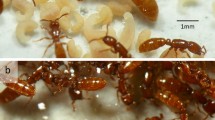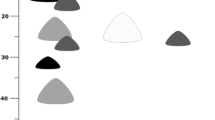Summary
Last instar larvae ofLasius niger under standard laboratory conditions and abundant food supply feed on conspecific eggs and, if forced to a choice, show a significant statistical preference for trophic versus fertilized eggs (approx. 60% of the trials observed). On the other hand, they are unable to discriminate between kin and non-kin eggs, both fertilized and trophic. Fertilized eggs killed by freezing and trophic eggs handled in the same way are also selected in a random manner.
Last instar larvae ofMessor semirufus regularly failed to discriminate in a significant way between trophic and fertilized and between kin and non-kin eggs.
Substantial experimental evidence confirms that larvae of both these species — as already suggested in the literature for other ants-rely on trophic eggs as an essential component of their diet in order to be able to develop. Additionally,L. niger last instar larvae appear to be able to attack and pierce the egg chorion with their own mandibles, while this capacity is at least very reduced or very rare inM. semirufus. First and second instar larvae of both species never succeeded in piercing the egg membrane alone.
These findings imply that the “right” (i.e. trophic) eggs should be presented to the larvae by the workers (i.e. worker discrimination should be assumed) and, at least in the case of youngLasius larvae, and probably for all stages ofMessor larvae, the egg membrane must be pierced by the workers in order to allow the larvae to feed.
The following evolutionary sequence is suggested to explain the origin of trophic eggs in ants: 1) larval oophagy (obligatory at least for the species founding new colonies in an independent claustral manner), 2) generalized facultative or obligatory larval oophagy for larvae of all colonial stages, 3) production of trophic eggs by the queen(s) and/or workers in order to avoid cannibalism of nestmates.
Lack of discrimination or weak discrimination capacity between trophic and fertilized eggs and the consequent larval cannibalism in form of oophagy, as demonstrated in this paper, is suggested to explain age segregation among eggs and larvae from workers, a widespread phenomenon in ants which must have been selected to avoid the oophagy of viable eggs.
Similar content being viewed by others
References
André, E., 1885, Les fourmis.Hachette et Cie., Paris, iv+347 pp.
Autuori, M., 1940. Algumas observações sobre formigas cultivadoras de fungo.Rev. Entomol. 11:215–226, 12 pl.
Baroni Urbani, C., 1989. On a singular case of kin selection theory among Hymenoptera: justified fratricide and the natural way to avoid it.Ethol. Ecol. Evol. 1:373–378.
Bazire-Bénazet, M., 1970. La ponte des ouvrièresd'Atta laevigata Fred. Smith 1858 (Hym. Form.).C.R. Acad. Sci. Paris, Série D 270:1614–1615.
Brian, M. V., 1968. Regulation of sexual production in an ant society.Coll. Int. C.N.R.S., Paris, 1967,173:61–76.
Brian, M. V., 1983.Social insects. Ecology and behavioural biology. Chapman and Hall, London and New York, x + 377 pp.
Brian, M. V., 1986. The importance of daylength and queens for larval care by young workers by the antMyrmica rubraL.Physiol. Entomol. 11:239–249.
Brothers, C. D. and C. D. Michener, 1974. Interactions in colonies of primitively social bees, III. Ethometry of division of labor inLasioglossum zephyrum.J. Comp. Physiol. 90:129–168.
Carlin, N. F., 1988. Species, kin and other forms of recognition in the brood discrimination behavior of ants. In:Advances in myrmecology (J. C. Trager, Ed.), E. J. Brill, Leiden, pp. 267–295.
Colombel, P., 1974. L'élevage artificiel du couvain d'Odontomachus haematodes L. (Hym. Form. Ponerinae) et la différenciation trophogénique des ouvrières et des reines.C. R. Acad. Sci. Paris, Série D 279:489–491.
Crespi, B., 1991. Cannibalism and trophic eggs in subsocial and eusocial insects. In:The ecology and evolution of animal cannibalism (M. Elgar and B. Crespi, Eds.). Oxford Univ. Press, Oxford, in press.
Belage, B., 1968. Recherches sur les fourmis moissonneuses du Bassin Aquitain: écologie et biologie.Bull Biol. 102:315–367.
Eidmann, H., 1936. Zur Kenntnis der BlattschneiderameiseAtta sexdens L., insbesondere ihre Ökologie. I & II.Z. angew. Entomol. 22:185–241, 385–436.
Freeland, J., 1958. Biological and social patterns in the Australian bulldog ants of the genusMyrmecia.Aust. J. Zool. 6:1–18, 2 pl.
Grandi, G., 1970. Singolare ovogenesi nella vita sociale delie formiche: le uova “alimentari”.Atti Accad. Sci. Ist. Bologna, Cl. Sci. Fis., Mem., Serie II, No. 9:5–13.
Hamilton, W. D., 1972. Altruism and related phenomena, mainly in social insects.Annu. Rev. Ecol. Syst. 3:193–232.
Van der Have, T. M., J. J. Boomsma and S. B. J. Menken, 1988. Sex-investment ratios and relatedness in the monogynous antLasius niger(L.).Evolution 42:160–172.
Hölldobler, B. and E. O. Wilson, 1990.The Ants. 16 col. pi. The Belknap Press of Harvard University Press, xiv + 732 pp.
Huber, J., 1905. Über die Koloniegründung beiAtta sexdens L.Biol. Centralbl. 25:625–635.
Huber, P., 1810.Recherches sur les moeurs des fourmis indigènes. 2 pl. J. J. Pachoud, Paris and Genève, xvi + 328 pp.
Isingrini, M., A. Lenoir and P. Jaisson. 1985. Preimaginal learning as a basis of colony-brood recognition in the antCataglyphis cursor.Proc. Natl. Acad. Sci. USA 82:8545–8547.
Le Masne, G., 1953. Observations sur les relations entre le couvain et les adultes chez les fourmis.Ann. Sci. Nat., Zool., 11esér., 75:1–56.
Lubbock, J., 1883.Fourmis abeilles et guêpes. Études expérimentales sur r organisation et les moeurs des sociétés d'insectes hyménoptères. (French enlarged edition).Tome Premier. 13 pl. Germer Bailiiere et Cie., Paris. 195 pp.
O'Neal, J. and G. P. Markin, 1973. Brood nutrition and parental relationships of the imported fire antSolenopsis invicta.J. Ga Entomol. Soc. 8:294–303.
Page, R. E., Jr., G. E. Robinson and M. K. Fondrk, 1989. Genetic specialists, kin recognition and nepotism in honey-bee colonies.Nature 338:576–579.
Passera, L., 1969. Biologie de la reproduction chezPlagiolepis pygmaea Latreille et ses deux parasites sociauxPlagiolepis grassei Le Masne et Passera atPlagiolepis xene Stärcke (Hymenoptera, Formicidae).Ann. Sci. Nat., Zool., 12 e Série,11:327–482.
Passera, L., 1984.L'organisation sociale des fourmis. Privat, Toulouse. 360 pp.
Peacock, A. D., I. C. Smith, D. W. Hall and A. T. Baxter, 1954. Studies in Pharaoh's ant,Monomorium pharaonis (L.) (8) Male production by parthenogenesis.Entomol. Mon. Mag. 90:154–158.
Poldi, B., 1965. Études sur la fondation des nids chez les fourmis. III. Élevage artificiel d'une larve deTetramorium caespitumL. C.R. V e Congr. UIEIS, Toulouse: 323–329.
Queller, D. C., C. R. Hughes and J. E. Strassmann, 1990. Wasps fail to make distinctions.Nature 344:388.
Stitz, H., 1937. Formicidae [I]. In:Tabulae biologicae periodicae, Vol. XI. (C. Oppenheimer and L. Pincussen, Eds.), W. Junk, The Hague, pp. 208–280.
Taki, A., 1987. The trophic eggs of colony founding ant queens.Proc. 10th Int. Congr. I.U.S.S.I.,Munich: 268.
Trivers, R. L. and H. Hare, 1976. Haplodiploidy and the evolution of social insects.Science 191:249–263.
Weir, J. S., 1959. Egg masses and early larval growth inMyrmica.Ins. Soc. 6:187–201.
West-Eberhard, M. J., 1981. Intragroup selection and the evolution of insect societies. In:Natural selection and social behavior. (R. W. Alexander and D. W. Tinkle, Eds.), Chiron Press, New York, pp. 3–17.
Wheeler, G. C. and J. Wheeler, 1976. Ant larvae: review and synthesis.Mem. Entomol. Soc. Washington 7:v + 108 p.
Wilson, E. O., 1971.The insect societies. XII+ 548 pp. The Belknap Press of Harvard University Press, Cambridge, MA.
Author information
Authors and Affiliations
Rights and permissions
About this article
Cite this article
Urbani, C.B. Indiscriminate oophagy by ant larvae: an explanation for brood serial organization?. Ins. Soc 38, 229–239 (1991). https://doi.org/10.1007/BF01314909
Received:
Revised:
Accepted:
Issue Date:
DOI: https://doi.org/10.1007/BF01314909




